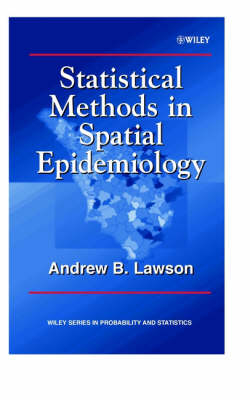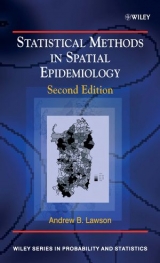
Statistical Methods in Spatial Epidemiology
Seiten
2001
John Wiley & Sons Ltd (Verlag)
9780471975724 (ISBN)
John Wiley & Sons Ltd (Verlag)
9780471975724 (ISBN)
- Titel ist leider vergriffen;
keine Neuauflage - Artikel merken
Zu diesem Artikel existiert eine Nachauflage
Spatial epidemiology considers the statistical aspects of disease development not only in relation to time, but in particular to geographical location. It also includes a range of applications for spatial epidemiology in medical statistics, from health economics to survival analysis.
Spatial Epidemiology is a rapidly growing field of research concerned with the analysis of the geographical distribution of disease. This principally involves mapping the location of disease cases and the analysis of the mapped data using spatial statistical methods. The growth of the field looks set to continue in line with increasing public, government and media concern about environmental and health issues. Comprehensive overview of the main statistical methods used in spatial epidemiology Contains many data examples -- each represents a different approach to the analysis, and provides an insight into the various modelling techniques Describes modern simulation--based methods suitable for highly complex modelling problems Discusses the wide range of software available for analysing spatial data Contains an extensive bibliography The first part of the book provides all the necessary definitions and terminology, introduces some data examples, and considers map construction along with some basic models.
The second part covers important problems in spatial epidemiology, with detailed coverage of disease mapping, ecological analysis, disease clustering and infectious disease modelling. Primarily aimed at medical statisticians, epidemiologists, environmental statisticians, and researchers in public health, this text will also appeal to postgraduate students of statistics or epidemiology.
Spatial Epidemiology is a rapidly growing field of research concerned with the analysis of the geographical distribution of disease. This principally involves mapping the location of disease cases and the analysis of the mapped data using spatial statistical methods. The growth of the field looks set to continue in line with increasing public, government and media concern about environmental and health issues. Comprehensive overview of the main statistical methods used in spatial epidemiology Contains many data examples -- each represents a different approach to the analysis, and provides an insight into the various modelling techniques Describes modern simulation--based methods suitable for highly complex modelling problems Discusses the wide range of software available for analysing spatial data Contains an extensive bibliography The first part of the book provides all the necessary definitions and terminology, introduces some data examples, and considers map construction along with some basic models.
The second part covers important problems in spatial epidemiology, with detailed coverage of disease mapping, ecological analysis, disease clustering and infectious disease modelling. Primarily aimed at medical statisticians, epidemiologists, environmental statisticians, and researchers in public health, this text will also appeal to postgraduate students of statistics or epidemiology.
Preface. THE NATURE OF SPATIAL EPIDEMIOLOGY. Definitions, Terminology and Data Sets. Scales of Measurement and Data Availability. Geographical Representation and Mapping. Basic Models. Exploratory Approaches, Parametric Estimation and Inference. IMPORTANT PROBLEMS IN SPATIAL EPIDEMIOLOGY. Small Scale: Disease Clustering. Small Scale: Putative Sources of Hazard. Large Scale: Disease Mapping. Large Scale: Surveillance. Ecological Analysis. Infectious Disease Modelling. Appendix A: Monte Carlo Testing and Simulation Envelopes. Appendix B: Markov Chain Monte Carlo Methods. Appendix C: Metropolis-Hastings Cluster Sampling. Appendix D: Glossary of Estimators. Appendix E: Software. Bibliography. Index
| Erscheint lt. Verlag | 29.1.2001 |
|---|---|
| Reihe/Serie | Wiley Series in Probability and Statistics |
| Zusatzinfo | glossary |
| Verlagsort | Chichester |
| Sprache | englisch |
| Maße | 156 x 235 mm |
| Gewicht | 550 g |
| Einbandart | gebunden |
| Themenwelt | Studium ► Querschnittsbereiche ► Epidemiologie / Med. Biometrie |
| ISBN-13 | 9780471975724 / 9780471975724 |
| Zustand | Neuware |
| Informationen gemäß Produktsicherheitsverordnung (GPSR) | |
| Haben Sie eine Frage zum Produkt? |
Mehr entdecken
aus dem Bereich
aus dem Bereich
ein überfälliges Gespräch zu einer Pandemie, die nicht die letzte …
Buch | Hardcover (2024)
Ullstein Buchverlage
CHF 34,95
Health Information for International Travel
Buch | Softcover (2025)
Oxford University Press Inc (Verlag)
CHF 85,50



